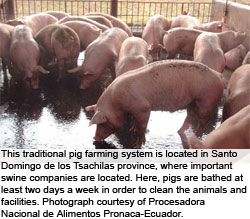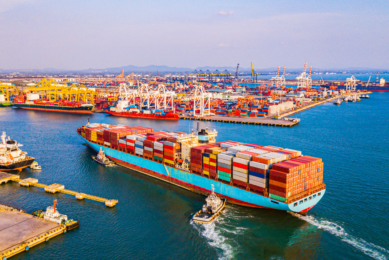Ecuador: Si, ¿se puede?

Although Ecuador is not well- known for its pork sector, the country’s production has steadily increased over the years. This increase has not been enough to keep up fully with consumption, though, let alone export. Both government and producers are joining forces and taking steps to promote a development of the sector in the country.By Dr Rogério G. T. da Cunha and Luciana Martins, Brazil
By Dr Rogério G.T. da Cunha and Luciana Martins, Brazil
During the soccer play-offs for the 2002 World Cup, a new yell was introduced in Ecuador. Ecuadorian fans successfully supported their national team with the phrase ‘Si, ¡se puede!’ – or, ‘Yes, we can!’. Now the big question is – will this yell help the country’s pork sector as well?
When it comes down to agriculture, Ecuador is mainly known for its oil extraction, the banana, shrimp and flower exports. As for pork, the country is not a main player on the Latin American stage. Brazil and Chile largely dominate the stage, while Argentina tries to catch up. Looking at the country’s production data (Figure 1), a substantial and consistent increase can be seen with regard to production over the years.
Pork sector in a snapshot
Figure 1 shows production figures, although with Brazil and Chile excluded. It is clear that a number of smaller countries have followed an erratic path over the years, most importantly Argentina. Others, however, showed a consistent production increase, most notably Ecuador. The country nearly reached Argentinean figures in 2008, according to FAO data.
This is not the full picture. First, Ecuadorian industrial pork production faces competition with poultry, a known story in many places. Over the years, pork and cattle production increased side by side, but chicken production took off in the 90s (Figure 2). So much so that it displaced pork from the second place, a situation reminiscent of some of its South American neighbours.
However, all in all, pork production sort of managed to keep up with consumption. True, production growth has not been enough to fully supply the internal market, even less to place it among the South American exporters. On the contrary, the country is still a small net pork importer.
Alfredo Acosta is a spokesperson for Agrocalidad, the Ecuadorian National Quality Assurance Agency. The organisation is responsible for defining and implementing policies, and the regulation and control of productive activities of national agriculture and animal husbandry. He states that most of the import comes from a trade agreement with Chile. “We buy around 12,000 metric tonnes/year, which represents 10% of the needs for industrialised skin, fat and trimmings,” says Acosta. On the other hand, there was a small exportation of processed products to Colombia in the early 2000s, but there is no recent data on that.
No trend follower
The second issue that details the picture is that the country does not follow the trend of the larger South American producers in terms of production structure. About 30% of the national herd is from backyard and small family-run farms. The largest portion of these goes to subsistence consumption and/or is sold in local farms. The remaining 70% of national pork production comes from so-called commercial farms and from a more industrial production. Within the first, Acosta explains that their sizes varies from five up to 100 sows, showing a medium degree of tecnification. “As for the industrial production, ten larger enterprises control the scenario. These start at 100 sows, and can have up to 8,000,” he details.
Larger-scale production is on the rise though, according to Acosta. “Big companies took off here some 15 years ago, and they have grown really fast,” he states. The most important ones are Pronaca, Molinos Champion, Ecarni-Don Diego, Crecult, Grupo Fernandez and Grupo Oro. Out of these, some have even developed their own pork brands. The advertisement of their products usually emphasises safety and quality standards, also trying to tap into the view of pork as a festive or holiday food (see Box ‘Ecuador breeds and their views on pork’).
Integration scheme
A peculiar aspect of these companies is that they do not significantly follow the standard integration scheme. According to José Orellana, director of the the Ecuadorian Association of Swine Producers (ASPE), they work from farm to table, so to speak, being responsible themselves from production to slaughtering to processing to distribution – and not outsourcing production, as is common in most other integrated structures. “As for the more local production/consumption, an important scheme exists, involving intermediaries. They buy pigs from the small/medium producers, selling them to slaughterhouses or in livestock fairs,” says Orellana.
On the direction of improving their production systems, the country is already participating in a project that has just been launched (Ibero-American network for the development of the pork production chain). The project’s website states that their objective is ‘to ensure an improvement in pork production through the development of sustainable and innovative production systems on health, nutrition, reproduction and production’. This approach is very much in line with the objectives of government and producers alike. Both Orellana and Acosta believe Ecuador will be self-sufficient in the near future, and then they can start thinking bigger. “Ecuador has optimal conditions for the development swine production. Therefore, our primary goal is first to satisfy the internal demand. Then, in the near future we aim to develop programmes to eradicate diseases in order to be able to export our products,” concludes Orellana.
| Ecuador breeds and views on pork In a paper by Ortiz (2001), dealing with the local breeds and traditional production systems in Ecuador, Iberian breeds have been the original source since colonial times. In a few isolated places, one can still find ‘pure’ animals, although their genetics is greatly impoverished. In most of the country, the author says, the so-called ‘criollo’ pigs (a word that would refer to a presumed pure Iberian origin), are in fact ‘mestizos’, that is, do show a mixture of different genetics. He defends that these local breeds should be preserved, similarly to what is being done in Europe, due to the interesting genetic characteristics. He states that they show rusticity and flexibility to a varied diet and are adapted to local climactic conditions, nutritional imbalances and diseases. Another interesting aspect is the special cultural relation between countryside Ecuadorian people and pork. It has a special place in their lives, being consumed on special occasions, such as religious or national holidays, or family events, such as marriages, baptism and the like. |
Health – a mixed picture
In a country largely dominated by small-scale and subsistence producers, it is not surprising that the animal health situation is a matter of concern. In fact, Acosta sees it as one of the main problems affecting the sector, alongside the smuggling of live animals from Peru.
As for the large enterprises, Acosta mentions that every company has its own programme of biosafety and good production and management practices, under the supervision of the sanitary authorities. However, an important (and large) step has just been taken. In collaboration with ASPE, the Ecuadorian government launched, as of January 2010, the National Swine Sanitary Program. The programme is under the coordination of Agrocalidad. “Here, we are guided by national and international standards. We direct our actions towards the protection and enhancement of agricultural production, the implementation of food safety practices, and the quality control of supplies. One of our aims is to support the preservation of public health and the environment, always incorporating the private sector and other actors in the implementation of plans, programmes and projects,” explains Acosta.
As for the programme, since it’s in its early infancy, there is no public document available in Agrocalidad for sharing yet. “In any case, it will involve updating the legal framework, the implementation of a Geographic Information System, the conduction of an epidemiological surveillance, carrying on a CSF vaccination programme, and disseminating good production practices,” Acosta says. The focus is mainly on the small and medium producers, supporting them in the adoption of good management practices.
“Besides,” he recalls, “the country is also participating in the Americas’ Classical Swine Fever (CSF) eradication programme, 2010-2020, sponsored and led by FAO and OIE.” According to him, all these actions are the first steps towards full eradication of important swine diseases, such as CSF, Foot-and-Mouth Disease (FMD) and cysticercosis.
Si, ¿se puede?
Considering the above, it seems that Ecuador really wants to foster its industrial pork production, although not losing its foothold on the small producers. In fact, the actions being undertaken points out that government, processing companies and producers are speaking the same language. Everybody is conscious that there is still a long way to go. Nonetheless, they are deliberately taking the necessary steps to promote a production that meets both safety and quality standards. Achieving that, the wishes and future vision of both Acosta and Orellana may well come true. Then, they will be able to say, now in relation to their pork sector: Si, ¡se puede!











